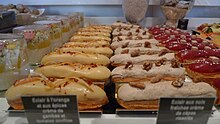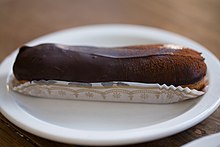Éclair
 | |
| Type | Pastry |
|---|---|
| Place of origin | France |
| Associated cuisine | French cuisine |
| Main ingredients | Choux pastry, flavoured cream filling, icing |

An éclair is an oblong pastry made with choux dough filled with a cream and topped with chocolate icing. The dough, which is the same as that used for profiterole, is typically piped into an oblong shape with a pastry bag and baked until it is crisp and hollow inside. Once cool, the pastry is then filled with a vanilla-, coffee- or chocolate-flavoured[1] custard (crème pâtissière), or with whipped cream, or chiboust cream; and then iced with fondant icing.[1] Other fillings include pistachio- and rum-flavoured custard, fruit-flavoured fillings, or chestnut purée. The icing is sometimes caramel, in which case the dessert may be called a bâton de Jacob.[2]
Etymology

The word comes from the French éclair, meaning "flash of lightning", so named because it is eaten quickly (in a flash);[3] however some[who?] believe that the name is due to the glisten of the frosting resembling lightning.[citation needed]
History
The éclair originated during the nineteenth century in France where it was called "pain à la Duchesse"[4] or "petite duchesse" until 1850.[5] The word is first attested both in English and in French in the 1860s.[6][7] Some food historians speculate that éclairs were first made by Antonin Carême (1784–1833), the famous French chef.[citation needed] The first known English-language recipe for éclairs appears in the Boston Cooking School Cook Book by Mrs. D.A. Lincoln, published in 1884.
North America
Some pastry chains in the United States and Canada[8] market Long John doughnuts as éclairs or éclair doughnuts. Long Johns are not identical to éclairs, as Long Johns use doughnut pastry, which is yeast-risen or batter-derived, rather than choux dough, which is steam-puffed. Long Johns are usually filled with vanilla pudding or custard and topped with cake icing. In Lima and Kenton, Ohio, these are more commonly known as "filled sticks".[citation needed]
See also
References
- ^ a b Montagné, Prosper, Larousse gastronomique: the new American edition of the world's greatest culinary encyclopedia, Jenifer Harvey Lang, ed., New York: Crown Publishers, 1988, p. 401 ISBN 978-0-517-57032-6
- ^ (Montagné 1961, p. 365, Éclair)
- ^ Éclair Archived 2014-01-04 at the Wayback Machine, Dictionnaire de l'Académie française, 8th edition
- ^ (Gouffé 1873, p. 288)
- ^ (Montagné 1961, p. 357, Duchesses)
- ^ Oxford English Dictionary, 1861. Petit Larousse, 1863.
- ^ (Gouffé 1873, p. 288) "On a changé, depuis une vingtaine d'années, le nom de ces gâteaux [pains à la duchesse] : on les désigne actuellement sous le nom d'éclairs. "
- ^ "Krispy Kreme Doughnuts". www.krispykreme.com. Archived from the original on 27 October 2017. Retrieved 4 May 2018.
Bibliography
- Gouffé, Jules (1873). "Deuxième Partie, Chapitre IX, "Pains à la duchesse au café"". Le livre de pâtisserie.
- Montagné, Prosper (1961). Larousse Gastronomique, The Encyclopedia of Wine, Food & Cookery (English translation).
